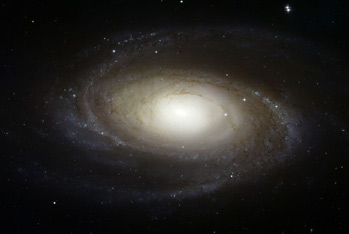
A just-released image of the galaxy Messier 81 reveals young blue stars in the spiral's arms. To download larger versions of this image, visit the Hubble website.
NASA, ESA, and The Hubble Heritage Team (STScI/AURA)
Astronomers were wowed yesterday as the clearest picture ever taken of the spiral galaxy Messier 81 was unveiled at the American Astronomical Society Meeting in Honolulu.
The bird's-eye view, taken by the Hubble Space Telescope, exposes individual stars ranging from hot blue ones only a few million years old in the spiral arms, to reddish ones about 600 million years old in the galaxy's center. The crisp resolution reveals open and globular star clusters (some with 100,000 stars each), dust trails winding into the galaxy's center, and masses of fluorescent hydrogen gas lit up by the ultraviolet light from young stars. Composed of observations taken over two years with the Advanced Camera for Surveys (which is no longer working), this stunning image will help scientists understand how star formation in the galaxy relates to neutron stars and black holes.
"We can use this image to help map star-forming activity across the galaxy and learn when and where stars and star clusters are formed," said Andreas Zezas (Harvard-Smithsonian Center for Astrophysics). Previous Hubble images indicate that M81 might have collided with its neighbors M82 and NGC 3077, causing a burst of star formation that began when the galaxy was only 300 to 600 million years old. The mergers triggered an incredible stellar baby boom, creating more than 100 super star clusters.
While the shape of the galaxy is similar to the Milky Way, M81 is much larger; the supermassive black hole resting at its center is about 70 million solar masses, 15 times that of the Milky Way's.
"The view we have of M81 is similar to what an astronomer in Andromeda would see if they looked at the Milky Way," said Zezas in a press release.
Although 11.6 million light-years away, M81 is one of the brightest galaxies visible from Earth. Located the constellation Ursa Major (home of the Big Dipper), the galaxy is detectable with binoculars, a small telescope, or occasionally even the naked eye.
Paul Deans contributed to this story.
 0
0
Comments
You must be logged in to post a comment.